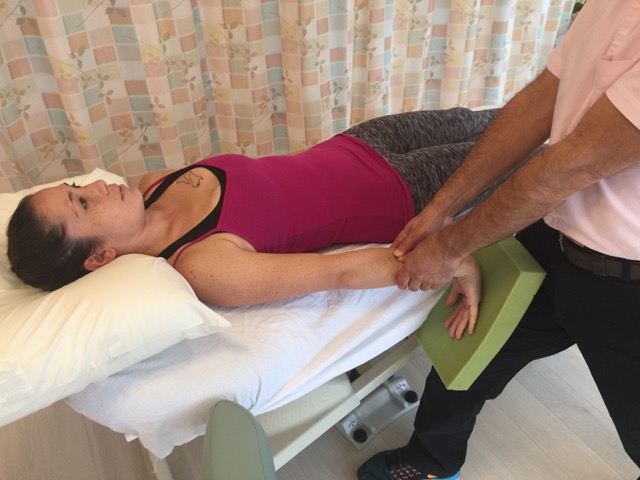Manual therapy treatment for wrist sprains, strains, and tendinitis can differ depending on the condition and on the stage of the condition.
Acute Stage for Wrist Sprain, Strain, and Tendinitis
For all three conditions, wrist sprain, wrist strain, and wrist tendinitis, when in the acute stage, ice should be used for the swelling. Gentle effleurage from distal to proximal can be helpful toward dispelling inflammation.
Chronic Stage – Wrist Strain and Tendinitis

Simultaneously stretching and massaging the extensors of the wrist joint. Permission: Joseph E. Muscolino.
In the chronic stage of treatment for wrist strain and tendinitis, massage and other manual therapy treatment for a strain is principally geared toward relieving tension and adhesions in the bellies of the affected musculature. Most any stroke can be used for muscle belly strains: however, a good protocol to follow is longitudinal stripping strokes along the length of the muscle, performed distally to proximally. Pressure should begin light and gradually transition to deep as the work progresses. Cross fiber work should then be done for the entire length of these muscles, but should be especially concentrated near their proximal attachment sites.
Stretching is also beneficial. Stretching the hand into flexion at the wrist joint stretches the posterior forearm wrist extensors; and stretching the hand into extension stretches the anterior forearm wrist flexors, but caution should be exercised because end ranges of wrist flexion and extension increase compression into the carpal tunnel.
And of course, stretching can be combined with massage. For example, the hand can be stretched at the wrist joint into flexion (thereby stretching the wrist extensors) while massaging the wrist extensors. Similarly, the hand can be stretched at the wrist joint into extension (thereby stretching the wrist flexors) while massaging the wrist flexors.
Tendinitis generally responds best to cross fiber friction techniques. Stretching the wrist joint is also indicated.
Chronic Stage – Wrist Sprain
A wrist sprain is more challenging to treat because it is essentially an overstretching of ligaments, which causes joint instability. This is challenging to treats because soft tissue manipulation is effective at making tight/taut tissue looser, not making lax tissue tauter. Massage can be done to the region to prevent excessive fascial adhesion from developing, but even here, caution is advised because the development of fascial adhesions may aid in increasing stability to the region. However, massage can indirectly help a ligamentous sprain by improving the ability of a muscle to contract and stabilize the region by removing pain and dysfunction due to tightness and myofascial trigger points.
For both acute and chronic cases of wrist sprain, once direct care to the forearm region has been done, it is wise to work the arm and shoulder girdle region. Begin proximally at the shoulder girdle and work your way down to the elbow.
Summary of Manual Treatment Protocol for Acute Wrist Sprain / Strain / Tendinitis
| 1. RICE (rest, ice, compression, elevation) |
| 2. Gentle effleurage |
| 3. Work shoulder girdle and arm on that side |
Summary of Manual Treatment Protocol for Chronic Wrist Sprain / Strain / Tendinitis
| 1. Longitudinal strokes to the forearm |
| 2. Cross fiber work to the forearm |
| 3. Cross fiber friction to the tendons |
| 4. Stretching to the wrist |
| 5. Work shoulder girdle and arm on that side |
Precautions/Contraindications
When working on a client/patient who has a wrist sprain, strain, or tendinitis, it is important to avoid placing excessive pressure directly on the median nerve, which is relatively superficial and vulnerable as it passes through the carpal tunnel, midline in the anterior wrist.
Self-Care for the Client/Patient
Self-care is an extremely important aspect of the treatment for a wrist sprain, strain, and tendinitis. Because these conditions are usually due to overuse, the client/patient should be advised to avoid offending postures and activities as much as possible.
When acute, RICE (rest, ice, compression, and elevation) should be recommended. Because the wrist region is so small, to prevent frostbite, ice should only be left on for a short time, approximately 3-8 minutes depending on how cold the ice application is. Also advise the client/patient that compression should not be too strong, otherwise blood supply might be compromised. Elevation of the wrist can be difficult to do; when done, it is important that the client/patient passively rests the upper extremity in an elevated position and does not isometrically contract shoulder musculature to achieve. If the condition is severe enough, a brace can be recommended, patients/clients may also choose to take over-the-counter anti-inflammatory medication.
Once the acute stage is resolved, stretching of the wrist joint can be recommended. If and when signs and symptoms of the condition have resolved, strengthening the forearm/hand musculature should be recommended.


